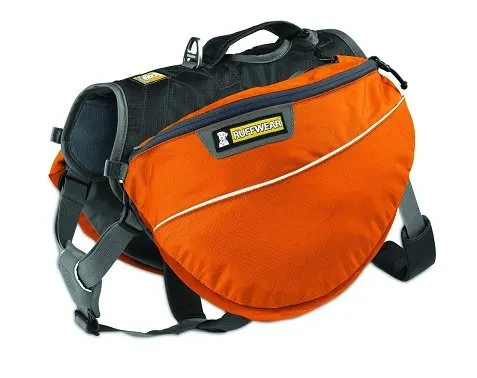We have a 1-year-old weimaraner at the time of this writing and a senior black Lab mix living in our 2-bedroom, 2nd-floor apartment. This post is all about how we live with a hyper dog in an apartment.
Our senior dog is very mellow, and he’s lived in apartments most of his life. Our weimaraner Remy on the other hand is a typical weim. Calling him high-energy would be an understatement!
Some people think this is wrong, cruel even, to keep a large dog in an apartment with no yard. That’s up to each individual to decide, but I don’t feel one bit sorry for Remy. This dog has it good!
I’m proud I’ve walked my weimaraner almost every single day for the year and 2 months that we’ve had him. The first day we got him, we walked 1 mile. He was 8 weeks old. Most days we go about 3 miles, which isn’t enough, but we get by.
How to manage a hyper dog in an apartment
Here’s how I manage my hyper dog while living in an apartment.
You’ll notice that this is no different than managing a hyper dog in pretty much any environment!

1. We go for walks every single day.
And I mean EVERY day. We can’t miss a day.
Even on the day Remy was neutered, we walked before I dropped him off at the vet. The following day, we still walked 20 minutes with the vet’s approval. The day after that we were back to our usual 40 minutes.
If you have an active dog and you live in an apartment, you walk. A lot. Period.
2. We have clear rules for our hyper dog.
Dogs need to learn boundaries whether they are tired, excited, bored, playful or anxious.
We live in a small space, and we can’t have our maniac of a dog tearing around non-stop even if he has energy to burn.
So, we don’t tolerate a lot of rough play, chasing games, wrestling, etc. It helps that our senior dog does not tolerate this either. I will play tug with Remy for about 5 minutes most days, and then I put the toy away.
Here are some of our other rules. Our dogs understand these rules because there are no exceptions.
Rules:
- No dogs on the couch.
- No paws on the counter.
- Begging for food is not allowed.
- No chasing the cats.
- No chewing our stuff.
Now, if I could also get Remy to stop jumping on me, we’d be doing pretty good …

3. We use a kennel/crate for our hyper dog.
We use a kennel as needed to give Remy (and us) some down time. He sleeps in his kennel at night and even though we work from home, we put him in there for about 2 hours on the average day. This is a place where Remy knows to be calm.
See our post: Is it mean to use a crate for a dog?
4. We stick to a routine.
We walk for a half-hour at 6 a.m. and again for 40 or 45 minutes at 4 p.m. nearly every day. Remy also has his potty breaks and meals at roughly the same times every day and we put him to bed around 9 p.m. every night so he knows what to expect.
5. We run together every Saturday.
Part of our routine since January has been to go for a long run every Saturday morning. For us, a long run is an hour or more.
This seems to keep Remy slightly less energetic until about Monday afternoon when combined with his usual daily walks. We’ve recently started training for an ultra marathon with our dog, so these Saturday runs will keep getting longer.
6. We go to training classes.
Training with a local obedience class helps me focus on making training a priority. I’m not good at planning training throughout the week so the class really helps because at least we have that 1 hour every Saturday where Remy and I work on heel, sit, down, stay and come.
Classes HELP us a lot!
7. Chew toys & bully sticks.
We give Remy things to chew on like:
He has access to something to chew almost all the time. Because of this, he hasn’t chewed up our shoes or anything else of much importance.
I recently bought the Kong Wobbler puzzle toy, and I’m so glad I bought this! You fill it with dry food or treats and the dog has to push it around to get the food out. This keeps the pup busy for 30 minutes or so! Amazing! If you have a hyper dog in an apartment, I highly recommend puzzle toys like this one!
Get the Kong Wobbler on Amazon HERE.
8. Mental work & giving your dog a job
This is an area where I’m trying to improve. My dog is smart and he needs some sort of work to do. I’m not quite sure what Remy’s “job” is yet but he needs one. Maybe it’s our Saturday long runs. Maybe it’s wearing a dog backpack. Maybe it will be agility.
I’ve been playing “find it” with him where he looks for treats I hide throughout the room. He also has his new Kong Wobbler toy.
The point is, working dogs need to work and a walk generally doesn’t cut it.
9. Off-leash running
I have to admit I’m not very good at bringing Remy to places where he can run off leash, wrestle with other dogs or play fetch. This probably happens once every other month. I know, it’s bad!
I’m just not much of a dog beach or dog park person. But when I do take him, it makes a big difference. Probably more so than anything else we do.
So that’s pretty much it!
- 2 walks per day
- 1 long run on Saturdays
- 1 training class a week
- Plenty of chew toys.
- A crate for when we need a break from Crazy!
He’s rarely tired but at least he’s manageable!
Other ideas
A dog backpack. Add it to your shorter walks (We’ll be getting one soon!)
Dog daycare. Try it once a week and see if you like it and if it’s a good fit for your dog. I’ve thought about it but haven’t tried it yet.
Hire a dog walker once a week: Use this in addition to the walking you’re already doing or to give yourself a break once a week.
Join a dog walking group. This is a good way to tire your dog out mentally as he’ll be walking in new places and seeing other dogs.
So as you can see, living with a super high energy dog in an apartment is a lot of work but it’s really not that bad. You just have to change your routine quite a bit and be dedicated to exercise. Otherwise, it’s not fair to the dog and he’ll probably start having more serious behavior problems.
Sometimes we joke about how Remy might be if we never walked him … he’d probably be at the humane society by now!
Do you have a dog in an apartment?
What are your management and exercise tips?
Let me know in the comments! It is helpful for myself and others to hear from people who understand the madness! Haha.
This post was originally published in 2017 and was updated in November 2019.
That Mutt is a participant in Amazon’s affiliate advertising program. As an Amazon Associate, That Mutt earns money from qualifying purchases.
Lindsay Stordahl is the founder of That Mutt. She writes about dog training and behavior, healthy raw food for pets and running with dogs.



Tina
Wednesday 3rd of January 2024
I have a question: I have a one year old gsd. Super smart and likes people most of the time. However, when someone visits, we get him adjusted to them to the point where he asks them to play or for attention, they'll play and all of that but then they'll use the restroom or something then when they go to come out he acts like he's never seen them before and we have to start so over. I don't get it. Or like my sons friends who come over every weekend. We have to introduce them every time they come but then if they go in my sons room then come out then again, we have to start all over again because he acts like he's never seen them before and they've been coming to our house for over a year!!
Vicky
Thursday 21st of November 2019
I live in the middle of New York City with my six-year-old German Shepherd and siamese/X cat. We have a kitchen, bathroom, short hallway and main room; all that just to say that it is not a large place. When I first brought home my current dog, Kilo, I had a lot of trouble channeling all his energy. I have had a number of dogs in this apartment over the years, but Kilo was unique in that he required (and still requires) a great deal of attention and management. There is a dog park not far away, But it was “down-sized” and is now so small that it’s dangerous. (thirty strange dogs in a very small pen is a recipe for disaster.) so, in addition to his regular guide work, kilo gets time in an underwater treadmill. this helps a lot. We, too, have a lot of puzzles, mostly the Nina Ottosson kind as well as indoor ball playing. I would give anything to have a place he could run off-leash outside, but such is not the case. he’s gotten much better then when I first got him. He no longer choose things or devours paper towels. There are times when I still feel as if I have a six-year-old child Who is constantly yelling, “ look at me!” But he’s a smart funny dog and I think the world of him. earlier this year, he had surgery on his paw and couldn’t do anything for six weeks, other than short trips outside to relieve. We drove each other up the walls, but we managed. so, if I can do it, so can you.
Lindsay Stordahl
Monday 25th of November 2019
Sounds like you are doing a great job with him! It's challenging but doable!
Grace
Friday 7th of June 2019
Hi, I have a 7 month old Dalmatian pup and I am considering moving into a downtown city apartment. I currently live in a more rural area with a yard for my pup to run around in. I have put him in training for two months and he knows the basic commands ( Sit, Down, Heel, Wait, etc.) and he is pretty good at leash walking. Our current struggles lie when we go into the city now, if it is not a super super busy day on the streets he behaves very well for such a young pup, but on a busier day he starts to get nervous. When he gets nervous he will attempt to jump on passing bystanders (obviously I don’t let him) but it is a struggle and worry that I have about moving into a big downtown area like London. I was curious if this was a struggle for you while your Dalmatian was a puppy and if so how you dealt with this. I plan to take the subway and public transportation, so before I move I want to be able to trust that he will be civil and respectful in a public setting. I was also wondering what you do with your dog while you are at work?
Hayley Dawson
Wednesday 31st of October 2018
Im thinking of adopting a dog rescued from china by a friend. Its been housed by a foster family with 2 kids. To me it looks to have border collie and labrador so im expecting high energy. However we live in a 2 bed flat and have a 3 year old so im wondering if this is a bad decision. Then again i work from home and can therefore get hom out for 4 walks a day around school run and in the lunch break. The dog would be about 7 months old if we take him. Im in the middle of making a decision any thoughts appreciated
Chris
Friday 22nd of November 2019
The issue I have w my weim is the he loves to walk but he is scared of noises. We start out great with a little trot but then after we go a short block or two he hears something, stops in his tracks and pulls us home like a sled dog. Any thoughts on getting Gunther to enjoy a walk without the anxiety?
Danitra Walker
Tuesday 7th of August 2018
I have a medium over hyper dog in my apartments he is a rat terrier mix beagle and we go on 4 walk a day the first morning walk is an hour long then at 1pm its 20 mins basically then again at 6pm that's the hour walk when its cooler out then one last 15 or 30 min walk at 9ish. At night he sleeps on the couch and the kitchen is gated off so he dont go in the trash. Then only time he is in a kennel is when I'm gone longer then 4 hours during the day because during the day he has pee accidents not so much at night as he does during the day. It's a big enough kennel to have food and a bed in but he always chews up anything that's in the kennel with him he hates the kennel. We also go to dog parks on my off days because he loves playing with other dogs. But sometimes I feel selfish for keeping him and not getting more of a smaller lap dog when we dont have a back yard.
Lindsay Stordahl
Tuesday 7th of August 2018
You're doing a great job!